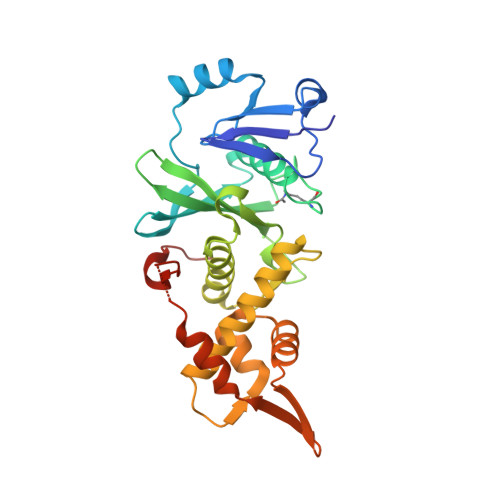HBO1 is required for the maintenance of leukaemia stem cells.
MacPherson, L., Anokye, J., Yeung, M.M., Lam, E.Y.N., Chan, Y.C., Weng, C.F., Yeh, P., Knezevic, K., Butler, M.S., Hoegl, A., Chan, K.L., Burr, M.L., Gearing, L.J., Willson, T., Liu, J., Choi, J., Yang, Y., Bilardi, R.A., Falk, H., Nguyen, N., Stupple, P.A., Peat, T.S., Zhang, M., de Silva, M., Carrasco-Pozo, C., Avery, V.M., Khoo, P.S., Dolezal, O., Dennis, M.L., Nuttall, S., Surjadi, R., Newman, J., Ren, B., Leaver, D.J., Sun, Y., Baell, J.B., Dovey, O., Vassiliou, G.S., Grebien, F., Dawson, S.J., Street, I.P., Monahan, B.J., Burns, C.J., Choudhary, C., Blewitt, M.E., Voss, A.K., Thomas, T., Dawson, M.A.(2020) Nature 577: 266-270
- PubMed: 31827282
- DOI: https://doi.org/10.1038/s41586-019-1835-6
- Primary Citation of Related Structures:
6MAJ, 6MAK - PubMed Abstract:
Acute myeloid leukaemia (AML) is a heterogeneous disease characterized by transcriptional dysregulation that results in a block in differentiation and increased malignant self-renewal. Various epigenetic therapies aimed at reversing these hallmarks of AML have progressed into clinical trials, but most show only modest efficacy owing to an inability to effectively eradicate leukaemia stem cells (LSCs) 1 . Here, to specifically identify novel dependencies in LSCs, we screened a bespoke library of small hairpin RNAs that target chromatin regulators in a unique ex vivo mouse model of LSCs. We identify the MYST acetyltransferase HBO1 (also known as KAT7 or MYST2) and several known members of the HBO1 protein complex as critical regulators of LSC maintenance. Using CRISPR domain screening and quantitative mass spectrometry, we identified the histone acetyltransferase domain of HBO1 as being essential in the acetylation of histone H3 at K14. H3 acetylated at K14 (H3K14ac) facilitates the processivity of RNA?polymerase?II to maintain the high expression of key genes (including Hoxa9 and Hoxa10) that help to sustain the functional properties of LSCs. To leverage this dependency therapeutically, we developed a highly potent small-molecule inhibitor of HBO1 and demonstrate its mode of activity as a competitive analogue of acetyl-CoA. Inhibition of HBO1 phenocopied our genetic data and showed efficacy in a broad range of human cell lines and primary AML cells from patients. These biological, structural and chemical insights into a therapeutic target in AML will enable the clinical translation of these findings.
Organizational Affiliation:
Peter MacCallum Cancer Centre, Melbourne, Victoria, Australia.





















